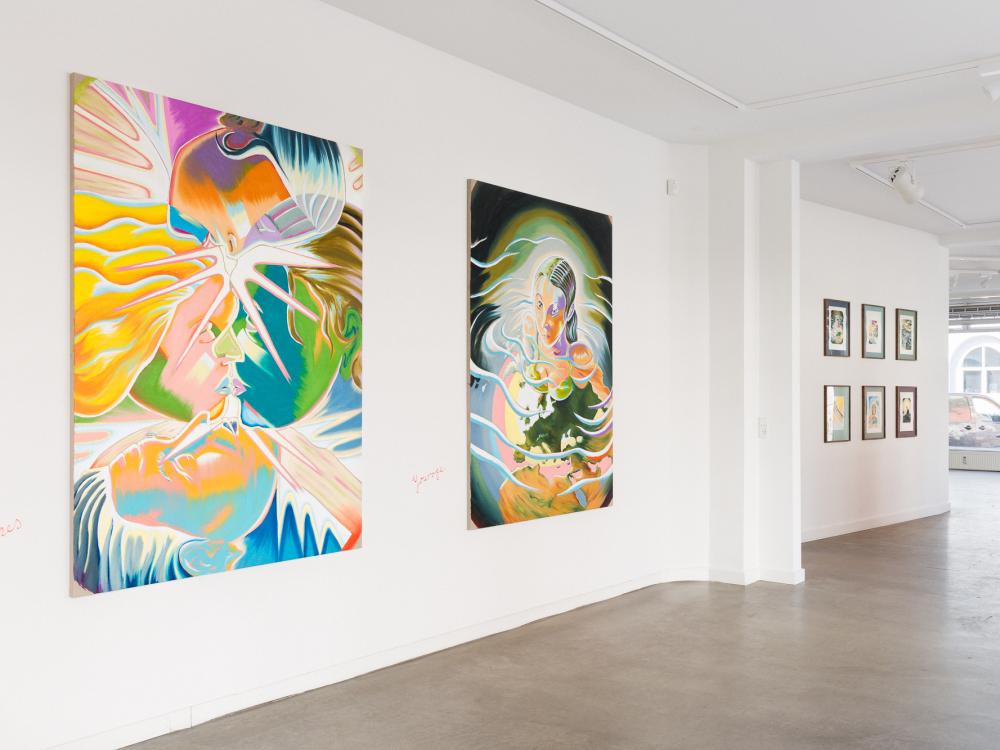In his first solo exhibition with Hans Alf Gallery, the already versatile painter Martin Bigum adds another dimension to his work with a new series of formidable, colourful, and intimately dramatic paintings. The exhibition culminates in a continuation of the site specific Hornbæk series.
A white flash light with a soft pink glow breaks through the picture plane from where hues of green, petroleum, violet and burned orange-yellow bursted with fine white brushstrokes spread out like cascades of coloured light seen through a prism. The explosive colour drama, inspired by the fragmented image composition of Cubism, without contours and almost without the use of primary colours, not to mention the lack of depth, is emblematic of Martin Bigum’s unique aesthetic. The work is titled The Kisses and presents four lovers. However, figuration is less important; it is the light and colours, their effect or authenticity, that Bigum is interested in. They are attractive in their generous and well-composed spectacle which, with noble simplicity and quiet grandeur - to use a classicist term - creates the intense, almost erotic, collision on the canvas.
In the intimate snapshots of scenes from every day life, we get a glimpse of the artist’s lifeworld. Yet, the paintings are not straightforward reproductions of what the artist sees; rather, he captures a momentary inner, or mental, image, or even a sensory perception. The paintings in Two Worlds, however, are not only about the complex relationship between what we experience and what we sense, but also about the complex relationship between openness and closedness, about gazes looking in (inner world) and gazes looking out (outer reality) or they alternate, one might say, between what the American art historian Michael Fried has called absorption and theatricality.
Facing each other, the lovers in The Kisses are mirrors of each other - and of their own inner selves. Almost everything in the image is symmetrical, and yet it is not. The four lovers form a frame around a centre: a light source from behind. Like many of the works in the exhibition, the image is absorptive, or self-contained. On a closer look, the term seems inadequate. A work like PFAS, for instance, is both-and; the woman in the painting is turned not towards us but towards her destination, preoccupied with her own journey into the water (one might wonder whether she is travelling inward or outward), but the painting does, however, create a kind of ramp between the space of the painting and the space of the viewer. Here, as in most of Bigum’s works, we get a sense that narrativity is not necessarily the ultimate purpose. Figure, background and foreground dissolve into a myriad of brushstrokes, contours and light - as in the reflection of rays of light in a shimmering sea of dust. The paintings are full of artistic presence and humour, even when the subjects are serious and contemporary. They are visual testimonies that, as Bigum says, hopefully provoke reflection on the times we live in - and the times to come.
Whereas the lighting in the larger paintings is theatrical or artificial, the light in the dioramic paintings of Hornbæk is completely natural (or as close to it as we can get). Painted plein air, the intimate land- and seascapes, with their typically raw corners, demonstrate why the area has been a frequent refuge for painters over the centuries. As painterly focal points, they bring us directly into the life of the present moment. In the Hornbæk paintings we experience Bigum’s unique ability to evoke light and colours. A method that we now see reflected in the larger paintings. With a natural feeling - something only the trained eye can see - he draws his bright, sometimes almost psychedelic colours from nature, one after one. Easily recognisable by the glorious light, Bigum lifts the subject out of the surface into a kind of symbolic shimmering sphere of alternating rays and life. Opening our eyes, Bigum’s paintings remind us that there is more than one kind of intimacy.
Martin Bigum (b. 1966) lives and works in Copenhagen. His works are represented in national and international collections, among others Arken, ARoS, SMK, Malmö Kunstmuseum, Bibliotheque Nationale and Musee d’Art Moderne de la Haute-Viennes. Since 1996, Bigum has mounted no less than museum 19 exhibitions, most recently at Arken, Frederiksborg Slot, Bornholms Kunstmuseum and Trapholt. Recognized as a popular painter, Bigum is also known as an exemplary communicator from, among other programmes, Kunstquizzen on DR. Over the years, he has written numerous essays on art for Weekendavisen, Politiken and Berlingske. In 2015, the autobiographical My Personal Art History about his artistic and personal inspirations was published by Gyldendal (now in its 7th edition). In 2020-2021, DR2 broadcast the documentary My Life’s Art with and by Martin Bigum.
Two Worlds will be on view until July 1. On Saturday, June 3, during Art Week, the gallery will host an artist talk with Martin Bigum about the exhibition and his artistic practice. The event is free to everyone, and no reservation is required.










